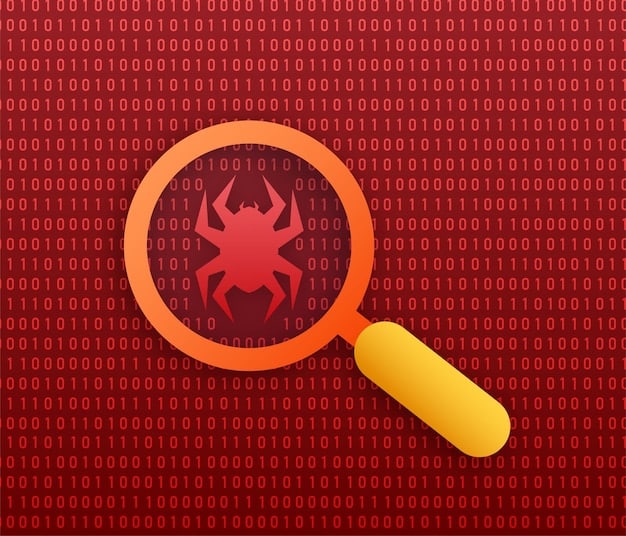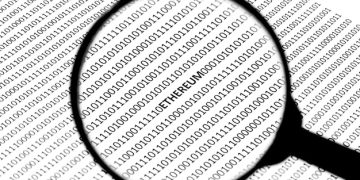How to Secure Your Smart Contracts: Audit Best Practices for 2025

Securing smart contracts is crucial for maintaining trust and preventing exploits; implementing robust audit practices is a key strategy for identifying vulnerabilities and ensuring the integrity of your code in 2025.
In the rapidly evolving world of blockchain, ensuring the security of your smart contracts is paramount. Our guide on how secure are your smart contracts? audit best practices for 2025 provides comprehensive insights into the latest techniques and strategies to safeguard your investments.
Understanding the Importance of Smart Contract Audits
Smart contracts are self-executing agreements written in code, and they power many decentralized applications (dApps) and blockchain-based systems. However, vulnerabilities in these contracts can lead to significant financial losses and reputational damage. That’s where smart contract audits come in.
A smart contract audit is a comprehensive review of your contract’s code to identify potential security flaws, bugs, and vulnerabilities. Think of it as a rigorous stress test for your code, ensuring it behaves as expected under various conditions.

Why Are Smart Contract Audits Essential?
Smart contract audits are not just a “nice-to-have”; they are a necessity. Here are a few reasons why:
- Prevent Financial Losses: Vulnerabilities can be exploited by hackers, leading to the loss of funds.
- Maintain User Trust: A secure and well-audited contract builds confidence among users and investors.
- Regulatory Compliance: As blockchain technology becomes more mainstream, regulatory bodies are likely to require security audits.
- Enhance Code Quality: Audits provide valuable feedback that can improve the overall quality of your code.
Ignoring the importance of smart contract audits can be a costly mistake, potentially undermining the entire project. Investing in thorough audits is a proactive step towards building a secure and trustworthy blockchain ecosystem.
In conclusion, understanding the critical role of smart contract audits is the first step toward ensuring the long-term viability and trustworthiness of your blockchain projects. By prioritizing security, you not only protect your assets but also contribute to the overall health of the decentralized economy.
Key Steps in a Smart Contract Audit Process
A smart contract audit is a multi-stage process that requires careful planning and execution. Understanding these steps can help you prepare effectively and ensure a comprehensive review.
The audit process typically involves several phases, from initial planning to final reporting. Each phase is designed to uncover potential issues and provide actionable recommendations.
Phase 1: Planning and Preparation
Before diving into the code, it’s essential to define the scope and objectives of the audit. This involves:
- Defining Scope: Identify the specific smart contracts and functionalities to be audited.
- Gathering Documentation: Provide auditors with comprehensive documentation, including specifications, architecture diagrams, and test cases.
- Setting Timelines: Establish realistic timelines for each phase of the audit.
Phase 2: Code Review and Static Analysis
This phase involves a detailed examination of the smart contract code. Auditors use a combination of manual review and automated tools to identify potential vulnerabilities.
Static analysis tools can automatically detect common security flaws, such as reentrancy vulnerabilities and integer overflows. However, manual code review is crucial for identifying more complex issues that automated tools might miss.

Phase 3: Dynamic Analysis and Testing
Dynamic analysis involves running the smart contract in a simulated environment to observe its behavior under various conditions. This includes:
- Fuzzing: Testing the contract with random inputs to uncover unexpected behavior.
- Unit Testing: Testing individual functions to ensure they perform as expected.
- Integration Testing: Testing the interaction between different smart contracts.
Phase 4: Reporting and Remediation
After the audit is complete, the auditors provide a detailed report outlining the findings and recommendations. This report typically includes:
- Executive Summary: A high-level overview of the audit findings.
- Detailed Findings: A description of each vulnerability, including its severity and potential impact.
- Recommendations: Specific steps to remediate the identified vulnerabilities.
The final step is addressing the issues raised in the audit report. This may involve modifying the code, adding additional security measures, or adjusting the contract’s functionality.
In summary, a well-structured audit process helps ensure that smart contracts are secure and reliable, reducing the risk of exploitation and maintaining trust in the system.
Common Smart Contract Vulnerabilities to Watch Out For
Smart contracts, although revolutionary, are susceptible to various vulnerabilities. Recognizing these potential flaws is crucial for developers and auditors alike.
These vulnerabilities can stem from a variety of sources, including coding errors, logical flaws, and outdated security practices. Understanding these risks is the first step toward mitigating them.
Reentrancy Attacks
Reentrancy is a classic vulnerability where a contract can recursively call itself before the initial invocation completes, leading to unexpected state changes.
To prevent reentrancy attacks, developers should use safe transfer patterns and avoid making state changes after external calls.
Integer Overflow and Underflow
Integer overflow and underflow occur when arithmetic operations exceed the maximum or minimum value that a variable can hold, leading to unexpected results.
Using SafeMath libraries or newer Solidity versions with built-in overflow checks can help prevent these issues.
Timestamp Dependence
Relying on block timestamps for critical logic can be risky, as miners have some control over the timestamp value.
Avoid using block timestamps for time-sensitive operations. Consider using block numbers or other more reliable sources of information.
Denial of Service (DoS)
DoS attacks can render a smart contract unusable by overwhelming it with requests or exploiting gas limit vulnerabilities.
Implementing gas limits and rate limiting can help mitigate DoS attacks. Also, carefully consider the gas costs of your functions.
Unchecked Call Return Values
Failing to check the return values of external calls can lead to unexpected behavior if the call fails.
Always check the return values of external calls to ensure they succeed. Use the “require” statement to revert transactions if a call fails.
In conclusion, being vigilant about these common vulnerabilities is essential for developing secure smart contracts. Regular audits and adherence to best practices can significantly reduce the risk of exploitation.
Best Practices for Securing Your Smart Contracts in 2025
As we move towards 2025, securing smart contracts requires a forward-thinking approach that incorporates the latest tools and techniques. Adopting these best practices can help you stay ahead of potential threats.
These practices cover a range of areas, from code development to deployment and ongoing monitoring. Implementing these strategies will significantly enhance the security posture of your smart contracts.
Use Formal Verification Tools
Formal verification involves using mathematical methods to prove that a smart contract meets its specifications. This can help identify subtle bugs that traditional testing might miss.
Tools like Certora and Mythril offer formal verification capabilities that can enhance the rigor of your security audits.
Implement Continuous Integration and Continuous Deployment (CI/CD)
CI/CD pipelines automate the testing and deployment process, ensuring that code changes are thoroughly vetted before they are released.
Integrating security checks into your CI/CD pipeline can help catch vulnerabilities early in the development lifecycle.
Employ Bug Bounty Programs
Bug bounty programs incentivize security researchers to find and report vulnerabilities in your smart contracts. This provides an additional layer of security by leveraging the expertise of external testers.
Platforms like HackerOne and Immunefi can help you set up and manage bug bounty programs.
Regularly Update and Patch Your Contracts
As new vulnerabilities are discovered, it’s essential to update and patch your smart contracts to address these issues.
Keeping up-to-date with the latest security advisories and applying patches promptly can help prevent exploitation.
Follow Secure Coding Guidelines
Adhering to secure coding guidelines can help reduce the risk of introducing vulnerabilities into your smart contracts.
Resources like the Solidity documentation and the ConsenSys Smart Contract Best Practices provide valuable guidance on secure coding practices.
In summary, adopting these best practices for securing smart contracts in 2025 will help you create more robust and reliable decentralized applications. Combining advanced tools with proactive strategies ensures that your projects are well-protected against emerging threats.
Choosing the Right Smart Contract Audit Firm
Selecting the right audit firm is a critical decision that can significantly impact the security of your smart contracts. Consider these factors when making your selection.
The reputation, expertise, and approach of the audit firm are all important considerations. Choosing a reputable and experienced firm can provide you with the assurance that your contracts are thoroughly reviewed.
Evaluate Their Expertise and Experience
Look for audit firms with deep expertise in smart contract security and a proven track record of identifying vulnerabilities.
Check their credentials, certifications, and past audit reports to assess their capabilities.
Consider Their Audit Methodology
Understand the audit methodology used by the firm. A comprehensive audit process should include both manual code review and automated testing.
Ensure that the firm employs a rigorous and systematic approach to identifying vulnerabilities.
Check Their Reputation and References
Research the firm’s reputation in the blockchain community. Look for reviews, testimonials, and case studies to gauge their reliability and professionalism.
Contact previous clients to get firsthand feedback on their experience with the firm.
Assess Their Communication and Reporting
Effective communication is essential for a successful audit. Choose a firm that provides clear and concise audit reports, and is responsive to your questions and concerns.
Ensure that the firm provides actionable recommendations for addressing identified vulnerabilities.
Compare Their Pricing and Contract Terms
Obtain quotes from multiple audit firms and compare their pricing and contract terms. Be wary of firms that offer exceptionally low prices, as this may indicate a lack of thoroughness.
Carefully review the contract terms to ensure that they protect your interests and provide adequate coverage for the audit.
In conclusion, choosing the right smart contract audit firm requires careful consideration and due diligence. By evaluating their expertise, methodology, reputation, communication, and pricing, you can select a partner that will help you secure your smart contracts and build trust in your projects.
Future Trends in Smart Contract Auditing
The field of smart contract auditing is continually evolving. Staying informed about emerging trends can help you anticipate future challenges and adopt proactive security measures.
These trends include advancements in automated tools, the integration of AI, and a growing focus on regulatory compliance. Embracing these developments can help you stay ahead of potential threats.
AI-Powered Auditing Tools
Artificial intelligence (AI) is increasingly being used to automate and enhance smart contract audits. AI-powered tools can detect complex vulnerabilities and provide more accurate results.
Look for audit firms that are leveraging AI to improve the efficiency and effectiveness of their services.
Formal Verification as a Standard Practice
Formal verification is becoming more widely adopted as a standard practice for securing smart contracts. This involves using mathematical methods to prove the correctness of your code.
As formal verification tools become more accessible and user-friendly, they are likely to play a more prominent role in smart contract audits.
Increased Regulatory Scrutiny
As blockchain technology becomes more mainstream, regulatory bodies are likely to increase their scrutiny of smart contract security. This may lead to mandatory audit requirements and stricter enforcement of security standards.
Focus on Decentralized Auditing
Decentralized auditing platforms are emerging as a way to provide more transparent and collaborative security reviews. These platforms allow multiple auditors to review a smart contract and provide feedback.
These platforms can help improve the quality and reliability of smart contract audits by leveraging the collective expertise of a diverse group of security professionals.
Integration of On-Chain Monitoring
On-chain monitoring involves continuously monitoring smart contract behavior to detect anomalies and potential attacks. This can help you identify and respond to security incidents in real-time.
Integrating on-chain monitoring with your audit process can provide an additional layer of security by detecting issues that might be missed during the initial audit.
In summary, future trends in smart contract auditing point towards more advanced tools, greater automation, and increased regulatory oversight. By staying informed about these developments and adopting proactive security measures, you can ensure that your smart contracts are well-protected against emerging threats and meet the evolving standards of the blockchain industry.
| Key Point | Brief Description |
|---|---|
| 🛡️ Importance of Audits | Audits prevent financial losses and maintain user trust. |
| ⚠️ Common Vulnerabilities | Reentrancy attacks and integer overflows are key risks. |
| ✅ Best Practices | Formal verification and CI/CD enhance security. |
| 🔎 Choosing Audit Firms | Expertise and reputation are essential factors. |
FAQ Section
▼
Smart contract audits are crucial to identify vulnerabilities that can lead to financial losses and reputational damage. They ensure contracts function as intended and are secure from exploits.
▼
Common vulnerabilities include reentrancy attacks, integer overflows, timestamp dependence, denial of service (DoS), and unchecked call return values. These flaws can be exploited by malicious actors.
▼
Best practices include using formal verification tools, implementing CI/CD, employing bug bounty programs, regularly updating contracts, and following secure coding guidelines. These practices enhance security.
▼
Evaluate their expertise, audit methodology, reputation, communication, and pricing. Look for firms with deep knowledge and a proven track record to ensure a thorough and reliable audit.
▼
Future trends include AI-powered auditing tools, formal verification as standard practice, increased regulatory scrutiny, decentralized auditing, and integration of on-chain monitoring. These advancements improve security.
Conclusion
Securing smart contracts is an ongoing process that requires vigilance, expertise, and the adoption of best practices. As the blockchain landscape evolves, staying informed and proactive is essential for protecting your investments and maintaining trust in decentralized systems. By implementing robust audit strategies and keeping abreast of future trends, you can ensure that your smart contracts are secure and reliable in 2025 and beyond.





